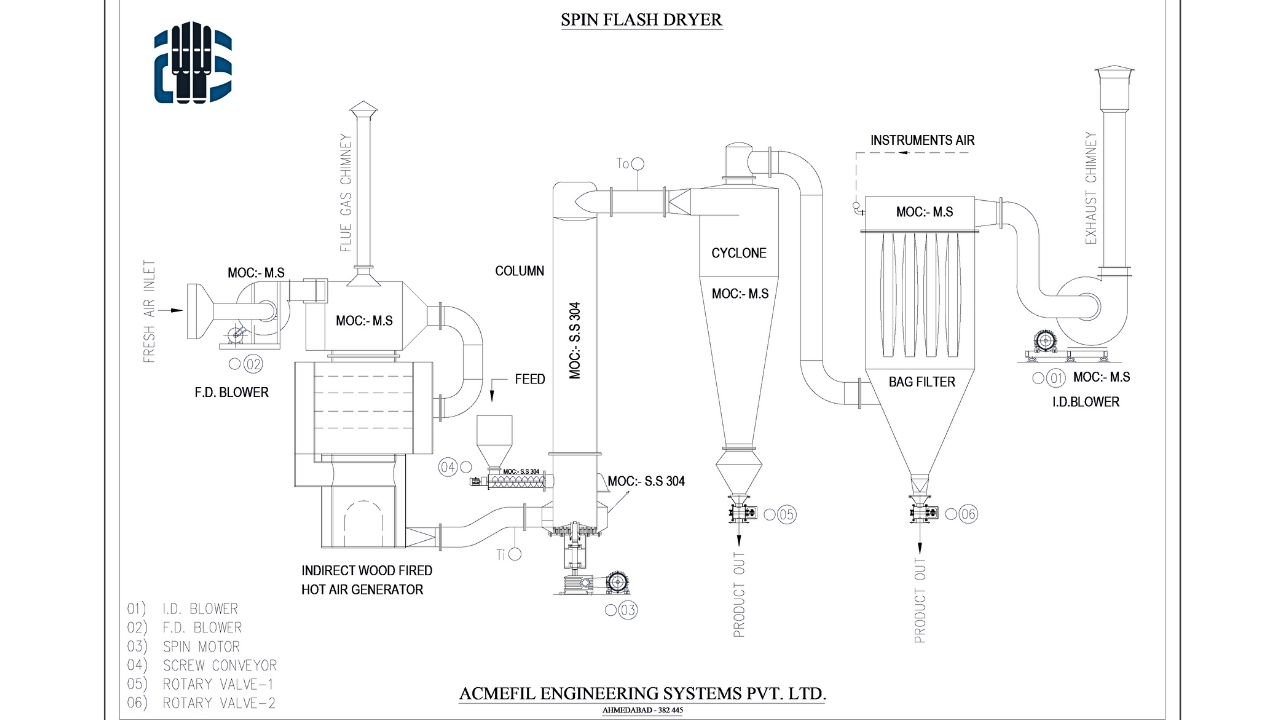A spin flash dryer offers an innovative and efficient solution for producing powder from feed materials that are typically viscous, gelatinous, or available as paste or filter cake. This drying technology leverages a two-step process: disintegration of the feed material followed by thorough drying. In this article, we will explore the workings, advantages, design configurations, and applications of spin flash dryers, providing comprehensive insights for those considering this drying solution.
Transform Your Drying Process with Acmefil Spin Flash Dryers – Unlock Efficiency and Savings Today!

The fundamental working principle of a spin flash dryer involves disintegrating the feed material and bringing it into contact with hot drying media. This dual action not only dries the particles swiftly but also pneumatically conveys them to a separation unit, such as a cyclone or bag filter. This efficient and controlled process ensures that only particles of the desired size exit the drying chamber, optimizing the drying performance.
In the first step, the feed material, often viscous or paste-like, enters the dryer. The system then disintegrates the material using high-speed rotating blades. These blades break down the material into smaller particles, significantly increasing the surface area for drying. Once the material is disintegrated, it immediately comes into contact with hot air or gas, initiating the drying process. The hot air quickly removes moisture from the particles, converting the wet feed into dry powder almost instantaneously.
The second step involves the pneumatic conveying of the dried particles to a separation unit. In most designs, a cyclone separator or bag filter captures the dry powder, while the exhaust air exits the system. This method ensures that the dryer operates efficiently, preventing any undesired particle sizes from escaping the drying chamber.
The design and configuration of a spin flash dryer vary depending on the nature of the feed material. For non-sticky, crystalline materials, a conventional arm design is suitable. This design employs a set of fixed arms or blades that help in the disintegration and drying process.
However, for handling sticky wet cake materials, a specially engineered rotating spin design disintegrator, like the one from Acmefil, is preferred. This configuration enhances the drying process and prevents clogging, ensuring smooth operation. The rotating blades in this design continuously mix and disintegrate the sticky feed, allowing for efficient drying and preventing material buildup within the dryer.
Moreover, the design also includes specific features to optimize the drying process. For instance, some dryers come with adjustable air flow and temperature controls, enabling operators to fine-tune the drying conditions based on the feed material’s characteristics. This flexibility ensures that the dryer can handle a wide range of materials, from heat-sensitive substances to those requiring high drying temperatures.
Spin flash dryers offer numerous benefits, making them an optimal choice for drying filter cakes, pastes, and high-viscosity liquids:
When selecting a spin flash dryer, it’s crucial to choose a manufacturer who can provide a system tailored to your specific requirements. Quality manufacturers like Acmefil offer not only standard designs but also customized solutions that cater to the unique needs of your drying process. A reliable manufacturer ensures optimal performance, durability, and efficiency of the dryer.
Consider the following factors when choosing a manufacturer:
Spin flash dryers are versatile and can be applied in various industries for drying a myriad of materials. Their ability to handle different material types and operational flexibility make them ideal for numerous applications, ensuring quality and consistency in the end products. Industries such as pharmaceuticals, food processing, chemicals, and ceramics benefit significantly from this drying technology.
Spin flash dryers represent a highly efficient and versatile solution for producing powder from various viscous and gelatinous materials. Their advanced design, economic operation, and environmental benefits make them a preferred choice across multiple industries. By choosing a reputable manufacturer and understanding the specific requirements of your drying process, you can leverage the full potential of spin flash dryer technology to enhance productivity and efficiency in your operations.
A spin flash dryer is a drying system designed to produce powder from viscous, gelatinous materials, paste, or filter cake through a two-step process involving disintegration and drying.
The dryer works by disintegrating the feed material and bringing it into contact with hot drying media. The particles are then pneumatically conveyed to a separation unit, ensuring efficient and controlled drying.
Benefits include high efficiency, economic operation, significant energy and fuel savings, operational simplicity, and environmental benefits.
Industries such as pharmaceuticals, food processing, chemicals, and ceramics use spin flash dryers for their ability to handle various material types and operational flexibility.
Choosing a reputable manufacturer like Acmefil, known for providing tailored and efficient drying solutions, ensures optimal performance and durability of the dryer.
Configurations vary based on feed material. Conventional arm designs are suitable for non-sticky, crystalline materials, while rotating spin design disintegrators are ideal for sticky wet cake materials.